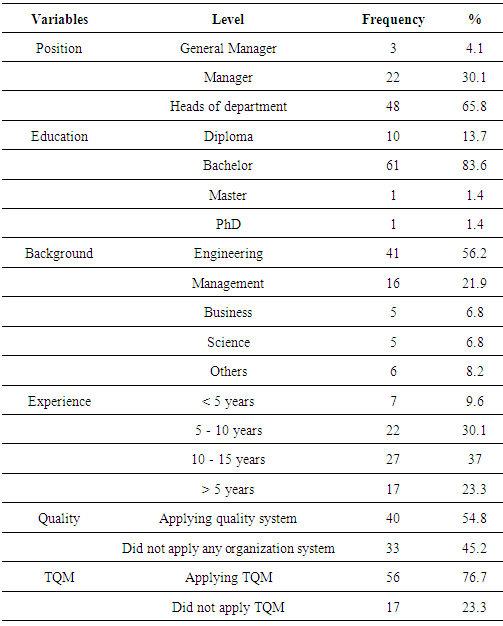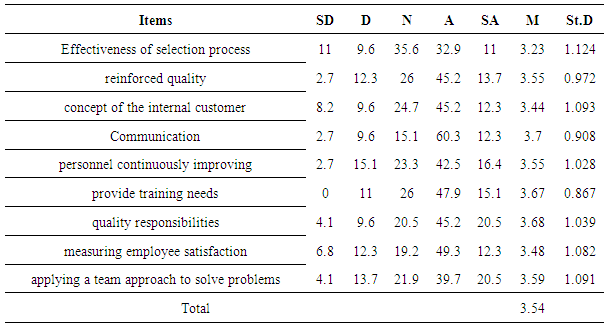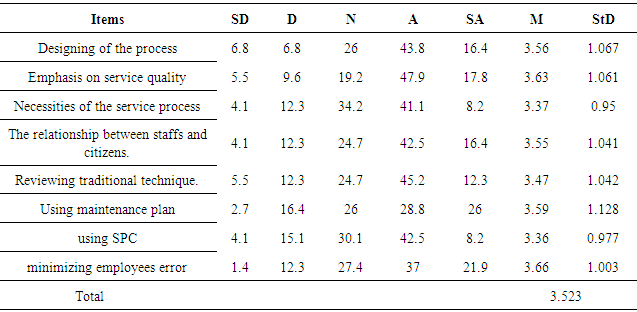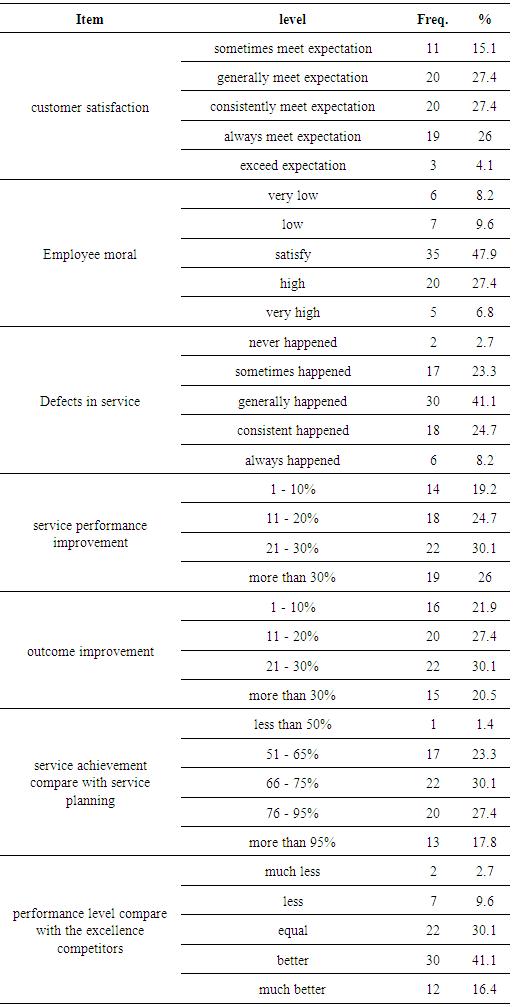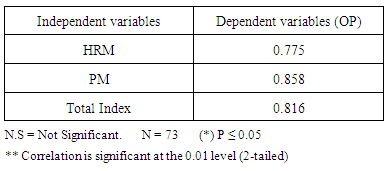-
Paper Information
- Next Paper
- Previous Paper
- Paper Submission
-
Journal Information
- About This Journal
- Editorial Board
- Current Issue
- Archive
- Author Guidelines
- Contact Us
International Journal of Tumor Therapy
p-ISSN: 2163-2189 e-ISSN: 2163-2197
2015; 4(1A): 7-15
doi:10.5923/c.ijtt.201501.02
Evaluating Impacts and Role of TQM Practices on Organization Performance of Public Sector in Iraqi Government
Jamal M. Saleh1, Mohd R. Hasan2
1General Directorate of Municipalities, (Ministry of Municipalities and Public Works, Iraq)
2Mechanical and Manufacturing Engineering Department, UPM, (Universiti Putra Malaysia, Malaysia)
Correspondence to: Jamal M. Saleh, General Directorate of Municipalities, (Ministry of Municipalities and Public Works, Iraq).
| Email: |  |
Copyright © 2015 Scientific & Academic Publishing. All Rights Reserved.
Nowadays, approaches and practices of Total Quality Management (TQM) as a modern management strategy in public sectors and governmental organizations are becoming one of the most successful management strategies to remedy and improve the weaknesses of service quality, lack in process management, and poor performance issues around the world. The objective of this study is to assess the impact and role of TQM philosophy and its critical factors on Organization Performance (OP) within Iraqi public-service organizations. TQM Critical Success Factors (CSFs) in this paper encompass Human Resource Management and Process Management. Based on a previous studies, the theoretical framework is established to achieve the purpose of this study, as well as, three hypotheses are performed and developed. A questionnaire was applied as an instrument for collecting data through answering the survey by general managers, managers, and department managers from 19 municipal institutions of the Ministry of Municipalities and Public Work (MMPW) in Iraq. The collected data are analysed using SPSS software Ver. 21, and the results pointed out that TQM as a comprehensive management approach, with human resource management and process management as key factors have a significant impact and positive role on OP in Iraqi context.
Keywords: TQM, Organization Performance, Human Resource Management, Process Management
Cite this paper: Jamal M. Saleh, Mohd R. Hasan, Evaluating Impacts and Role of TQM Practices on Organization Performance of Public Sector in Iraqi Government, International Journal of Tumor Therapy, Vol. 4 No. 1A, 2015, pp. 7-15. doi: 10.5923/c.ijtt.201501.02.
Article Outline
1. Introduction
- The main goal of any Governmental Organization (GO) is to provide the society and citizens with essential needs and requirements such as education, power, health care, and municipal services depending on the available resources and budgets. Consequently, many organizations trying to apply and embrace one or more of the management schemes that assist them in enhancing their productivity and success. One of the most significant management philosophies or business approaches is TQM. However, many countries and organizations around the world, in their effort to be flexible, effective and efficient in gaining the competitive advantages in business environment, have begun to recognize and understand the benefits and importance of quality revolution in term of TQM. The 1990s have witnessed spreading of the quality revolution to private and public service organizations from its cradle in manufacturing organizations [1]. In that time, many of (GOs) in service sector considered TQM as a significant management strategy for their survival. Therefore, these organizations started adopting this strategy but with different names and standards to remedy dissatisfaction about poor services, poor financial management, high inflation, performance problems and to get such comprehensive change in their organizations [2]. TQM brought huge changes to management and has a substantial impact on business systems globally through continuously seeking customers' needs and the way they can constantly be met [3]. This perception motivated GOs to evaluate their operations and to consider TQM practices as a changing factor and a way to define the certain citizens’ issues. This philosophy will help management team to; reduce the waste of rare sources, empower employees, and to define efficiently the defects in service processes [4]. The last few decades witnessed the upsurge of the concept of TQM in the governmental environment. Notwithstanding, TQM has been the focus of managers and has also been a fundamental element in the majority of the business policies set out by organizations [5].The aim of this research is; evaluating impacts of TQM practices on OP of GOs in Iraqi context. Improving the municipal performance and rising the quality of provided services has become essential for the municipalities, citizens, professionals, management teams, and governments in third world countries, in which citizens in these countries suffer from poor service quality with weakness in performance. This research is a try to checkup the impact of TQM on GOs performance in Iraqi context due to increase citizen’s expectations from governmental organizations to provide a service with good quality.
2. Literature Review
2.1. TQM Philosophy
- Quality development has passed in four stages which are; inspection, quality control, quality assurance, and the final stage in this development is TQM. In 1949 after the Second World War, the Union of Japanese Scientists and Engineers (JUSE) set up TQM as a managerial approach to enhance productivity and give better quality to life. In the 1980s and 1990s, the Americans and British took on the task to sophisticate TQM based on quality gurus such as Crosby, Juran, Ishikawa, and Deming [6]. The quality concept was described differently by many gurus, but there is agreement from all about considering meeting customer expectations by improving products and processes quality as primary goal [7]. Crosby (1979) [9] defined quality as an adherence to requirements, [8] identified it as a value perception, [10] declared that quality was fitness to use. These experts’ views contributed vastly to the total quality management domain in different ways; still, the essence and fundamentals stayed unchanged. In 1984, Rehder and Ralston issued a first paper on TQM entitled: “Total Quality Management: A revolutionary management philosophy” [11]. Many countries and organizations around the world, in their effort to be flexible, effective and efficient in gaining the competitive advantages in business environment, have begun to recognize and understand the benefits and importance of quality revolution in term of TQM [12]. Recently, several GOs decided to adopt TQM as a management strategy to get such comprehensive change in their organizations. TQM implementation in governmental organizations has advantages that are comparable to those advantages in privet organizations which involve reducing costs, increasing employee’s moral, improve public services and rising quality and productivity [13].
2.2. TQM Implementation and OP
- TQM is a very vague notion that is difficult to specifically explain. Several academics and researchers have developed numerous descriptions that best designate their appreciation of the term and have ensued an array of definitions not being expressively dissimilar in regard the original concepts [5]. Many researchers and experts have pointed out in their studies that, implementation of TQM has a significant and positive role in improving OP despite of the type and size of the organization [1, 3, 13, 12, 29]. On the other hand, some researchers have opposite opinion. In the scene, improving OP to enhance customer (citizens) satisfaction is the certain aims of TQM implementation through producing goods and services with high quality by stakeholder collaboration, building teamwork, and continuous improvement of performance by adopting quality management practices and tools [14]. Prajogo (2005) [15, 16] and Yusuf et al. (2007) [14] stated that TQM has a significant and positive effects on quality performance in both of service and manufacturing organizations. This opinion has been supported by [17] in their empirical study. The TQM application as a number of processes has a straight and significant influence for enhancing OP. TQM has been documented as a viable advantage for an institution’s success ever since the 1980s. It can be applied in service and manufacturing companies, in addition to organizations in industrialized and emerging countries [18]. The successful application and acceptance of TQM processes involves planning, time and determination factors [19]. From their point of view [20] emphasized on adopting quality management system well-defined as a way for improving OP. There is no specific approach for applying TQM principles in an organization to accomplish good results, but depend on the quality experts understanding [21]. Successful application of TQM can convey many advantages into the organization, including better employee contribution, enhanced communication, augmented output, enhanced quality and a reduced amount of rework, less costs of lowly quality, bigger market share and turnover, higher suppleness, increased personnel and consumer satisfaction, and enhanced competitive advantage. Nevertheless, in fact, TQM application is viewed as an intricate and difficult practice and these advantages are hard to attain [22]. From previous studies we can propose the next hypotheses as H1: TQM philosophy play a positive and significant role in improving OP.
2.2.1. Process Management (PM)
- PM is one of Critical Success Factors (CSFs) of TQM. The main focus for this factor is managing processes to provide products and services with high quality [22]. This element can be defined as a systematic way to improve organization performance through allocating and using available resources efficiently and effectively [23]. Motwani (2001) [24] in his research provided evidence that process management added value to process, improved the performance quality, and finally increased the outcome of each employee in the organization. Prajogo and Sohal (2004) [25], in their empirical study argued that there is a direct relationship between OP and PM. TQM gives a high attention for researching, understanding, and developing the process to get an effective process management [26]. PM involves defining and documenting PM procedures in order to ensure minimizing error likelihood. There are many methods like statistical process control, problem solving approach, fool proofing, failure mode effects analysis, and sampling and inspection, which are applied for controlling and improving the process [27]. In order to prevent produce goods and services with defects, there is a significant need to improve a system continuously [18]. Process management is essential to improve TQM practices through eliminate differences of all the stages of the process and by doing the correct things correctly in first time [28].As a conclusion, the process management as a CSF of TQM is playing a big role in designing service process to add value to citizens, sustaining a good relationship between staff and citizens, and reviewing of the service tools and techniques repeatedly. PM was measured through the subset of variables on: designing the service process in order to add value to the citizens, emphases on service effectiveness, providing the necessities of the service process, performing maintenance plans for producing equipment; improving and controlling the process by using SPC; minimizing employee’s errors. Hence, the following hypothesis is proposed as H2: PM has a significant impact and positive correlation with OP.
2.2.2. Human Resource Management (HRM)
- HRM is another key factor of TQM in service organization that associate strongly with customer satisfaction within organizations [23] by managing employees to work together in groups within an organization in order to improve organization performance. Furthermore, it has an essential role in TQM practices to be effective and efficient [29]. In his turn, [9] emphasized that employee’s involvement and empowerment as the main foundation of TQM strategy. In his side, [17] argued that HRM plays a big role in supporting the programmes of TQM in the organizations. Ishikawa (1985) mentioned that senior managers in any organization should motivate their employees to be totally involved by delegating responsibilities [30]. Additionally, all TQM factors require involving all the organization member to associate in improving quality [30]. Along with this idea, [3] stated that HRM is important for improving business performance and management processes. As a result, it is one of CSF in any successful TQM implementation and it is correlated with quality performance positively [31]. Employees Involvement can help an organization to modify and betterment some employees’ negative attitudes, minimize disagreement stemming from the working pressure, instil in them a good understanding of the importance of their role in producing products with high quality and establishing an organization-wide quality culture [27].In TQM implementation there is a significant affirmation on employee’s involvement and management within the organization by enabling them to participate meaningfully to the continuous improvement of the processes and their quality. Furthermore, TQM gives a high attention for having an open and creative organization’s culture, building a teamwork, and continuous improvement [18]. In their study, Juran and Gruna (1993) [32] supported this approach, they stated that TQM couldn’t work with tools and equipment only, there is always a need to human mind role to arrange and manage these tools and equipment. Through every step of TQM implementation there is an emphasis about participating all the staff in process of decision making, problem solving, and improving performance of the whole organization. In another word, TQM stimulates all employees’ levels to be very closely to the mission and vision of organization. Deros et al. (2006) [33] mentioned that HRM is one of the most of CSFs in improving performance and management process. Deming argued that employees empowerment and involvement at all step is necessary to improve the present and future goods and services quality. Therefore, to gain service performance, organizations have to utilize all employees’ capabilities and skills [31].Yang (2006) [33] and [23] in their studies noted that HRM as a TQM element significantly correlated and affected in customer satisfaction [23, 34]. Furthermore, [35] emphasized that empowerment and role of disagreement have a positive relationship. HRM is an essential factor in any successful implementation of TQM, and was involved in many researches and articles studies [35]. In their studies, many scientists and researchers have shown that HRM problems like, they don’t have enough experience and information about TQM practices implementation, lack and weakness of employee’s empowerment and motivation in TQM practices, changing employee’s work habits, team orientation weakness, inadequate time, are HRM barriers in successfully TQM implemented in service organization [21]. In real world, experts and researchers have confirmed that HRM has considerable influence on TQM implementation if there is agreement, harmony, and synergy among its practices. In another word, HRM is essential to success the implementation of TQM [29]. Accordingly, third hypotheses is, H3: HRM plays a positive and significant impact on improving OP.HRM can be measure using sub variables such as, how the process of staff selection be effective, take into the account the internal customer concept, creating and providing the necessary training for covering the TQM practices, examine repeatedly employees satisfactory and acceptance responsibilities for quality, problems can be solved by using team approach.
3. Methodology
- The main objective of this paper, as mentioned earlier, is specifying to what level TQM philosophy is implemented in Iraqi public sector and the impact of this philosophy on organization performance. A questionnaire was used, as an instrument for achieving research objective, and it was executed in selected municipalities of Iraqi Ministry of Municipalities and Public works (MMPW). The research methodology for this paper consist of theoretical framework, design of the study, and data collection process.
3.1. Theoretical Framework
- “A theoretical frame work is a conceptual model of how one makes logical sense of the relationship among the several factors that have been identified as important to the problem” [36]. Therefore, the theoretical framework is established to illustrate the impact of TQM philosophy and its impact on service performance in Iraqi context. The framework, based on a comprehensive literature review, is designed to define the research concepts as well as to illustrate the relationship between TQM as a management philosophy and OP, the effect of TQM factors separately on OP, and the relationship directions. Figure 1. shows the model used in this study, which illustrates the relationship between TQM elements and performance in service sector.
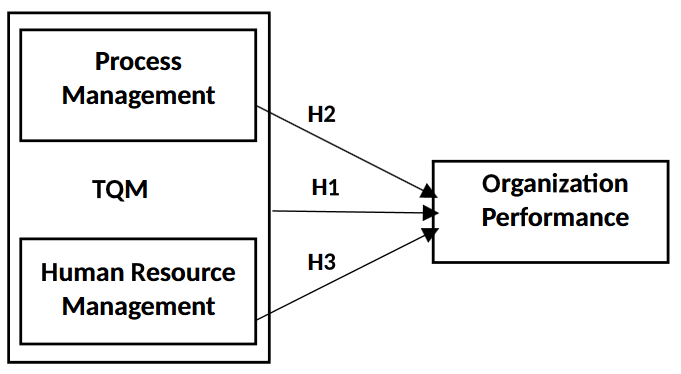 | Figure 1. Theoretical Framework |
3.2. Design of the Study
- The current study employs a descriptive cross-sectional method as study design due to its capability of phenomenon analyzing of, status, ideas, issues, and demographic information. Generally, most of studies about TQM implementation and OP in service sector have used this type of design [37]. However, the questionnaire with Likert five point scale was applied and consists of three parts. First part consists of general information about organization and respondents, such as, current position in the organization, respondent background, highest educational level, experience in this organization, and so on, this section included nine questions. Second part focuses on the extent and the actual implementation of the TQM elements within present status for the organization. HRM and PM are the key factors for TQM implementation to get successful implementation within municipalities. This section has seventeen questions, eight question about process management, and nine questions about human resource management. Third section in this questionnaire is a description and evaluation for the service performance level within the municipal organizations. It focuses on information about municipalities’ performance in term of customer satisfaction, employee morale, defects in service, service performance improvement, and outcome improvement. This part has only seven questions.
3.3. Data Collection
- The researchers are usually using many ways for collecting data, such as face to face interview, phone, messages, e-mail and questionnaire. However, for this study, data collection instrument was the survey methodology that was suggested by Powell (1995), along with necessary modification in order to collect the necessary data to achieve the research objectives and hypotheses [38]. The questionnaire questions were tested by Pilot Study and then improved and examined before the distribution process to the target respondents. The questionnaire with final structure have been distributed to all designated municipal institutions in Iraq and addressed to the general Managers, managers, and heads of department for these institutes. However, 25 municipal institutions were chosen to be a study sample. Data collection involves sending out the final questionnaire to 10 General Managers, 25 managers of 25 municipal institutions and 65 heads of department in 19 Iraqi cities as the main respondents. Respondents have to tick whether they are: Strongly Disagree (SD) with lowest value 1, Disagree (D) also has low value 2, Normal (N) with moderate value 3, Agree (A) with high value 4, or Strongly Agree (SA) with highest value 5, to any of these questions that they have been implemented in the organization. From these chosen respondents, only 4 general managers (4%), 19 managers (19%), and 50 heads of department (50%) accepted to response for this study. This represents 73% percent achieved of total respondents in selected municipal institutions which is considered as an acceptable rate.
4. Data Processing and Analysis
- For measuring the variables of this research, a scale of Likert five point ranging from SD=1 to SA=5 was applied for testing the impact of TQM on OP in the municipal organizations. A gross of 100 questionnaire were sent to general managers, managers, and heads of department as a management team and leaders for municipal organizations in 19 cities and towns in Iraqi context used for this research the total respondent’s rate was 73%. For analyzing the study data, the correlation analysis, descriptive statistical analysis, and multiple regression analysis, were used to assess the impact and the relationship of TQM philosophy and its elements on the performance of municipal organizations in Iraqi context by using SPSS software Ver. 21. Furthermore, for determining variable frequency, frequency statistics was performed. While, for testing questionnaire reliability, an internal consistency analysis, for finding Cronbach’s value was performed. The reliability analysis indicate that both independent variables (HRM and PM) and dependent variable (OP) have a Cronbach’s alpha above 0.8, which refers to high reliability of the questionnaire. As shown in Table 1 the reliability values of all variables were strongly significant with value more than 0.84 for all of them.
|
4.1. Descriptive Analysis
- The main purpose for using descriptive data analysis is descripting the interesting phenomenon [39]. In other word, this type of analysis used to analysis the descriptive information statistically to find frequency, Mean (M), and Standard deviation (St.D). Descriptive data analysis provides a general review of characteristics of variables and their measures. Furthermore, it is very important for getting fully understanding about the data collected and interpretation of results. Descriptive analysis is suitable tool for summarizing the results of the data collected in form of tables and/or graphs depending on measuring of the variables frequencies, M, and St.D.
4.1.1. Respondents’ Demographic Variables
- Ying (2015) in his study about the role of the managers background and the organizations characteristics indicated that these variables have a significant impact on OP [40]. Analyzing the characteristics of the sample based on the variables such as position, education experience, quality, TQM and number of Employees and the table 2 is presented the percentage for each item.
|
4.1.2. Human Resource Management (HRM)
- Exploring the suitability of HRM inside an organization before a quality program is implemented is a vital task [17]. This factor is aimed for identifying the status of the HRM among municipal institutions in Iraqi government. This dimension includes 9 items. Table 3 shows that the highest mean score belonged to, “Communication is open and continues in three direction.” with M=3.7 and St.D=0.908 followed by “Employees responsibility for quality and make suggestions.” With M=3.68 and St.D=1.039 and the lowest M value was observed for “Providing necessary training” with M=3.23 and St.D=1.124.
|
4.1.3. Process Management (PM)
- The aims of this factor is identifying the status of the PM among municipal institutions by measuring; value design the process, emphasis on effective service, relationship between staffs and citizens, maintenance plan, and minimizing the chance of employee error. Table 4 shows that the highest mean score was observed for “the processes designed to minimize the chance of employee error.” with (M=3.66, St.D=1.003) followed by “Emphasis on effective service delivery concerning quality.” with (M=3.63, St.D=1.061). The lowest mean score was observed for “using SPC for process control and improvement” with (M=3.36, St.D=0.977) and “The necessities of the service process are totally provided to guarantee value creation for citizens.” with (M=3.37, St.D=0.950). The overall mean of this dimensions was M=3.523 which showed that the level of overall process management was more than moderate level.
|
4.1.4. Organizational Performance (OP)
- OP as a dependent variable was measured the performance of government municipal organizations based on seven statements in terms different choice based on each items including customer satisfaction, employee morale, defects in service, service performance improvement, outcome improvement (in percent increase regions that get service), the percentage of service achievement compare with service planning, and the organization performance level compare with the excellence competitors. Table 5 shows the respondents feedback for above items.
|
4.2. Correlation Coefficient between TQM factors and OP
- Pearson’s correlation was performed to measure the existence of bivariate linear relationships and to find out how is significant the relationship between the independent variables (HRM and PM) and dependent variables (OP). The correlation helps to clarify how the variables are related in strength and magnitude. The Pearson correlation coefficient, r, was used for research variables due to normal distribution of all variables in this study to extent of linear relationship. Pearson r can take on only values from -1 to +1. This study used the platform of [41]. Table 6 shows the correlation coefficient and significance level for the relationship between these variables.
|
5. Conclusions
- The current study presented an exploratory research about the relationship between TQM strategy and its key elements and service’s performance within Iraqi municipal organizations. The research objectives have been achieved by measuring the response of the management teams in Iraqi’s municipal institutions about the role and impact of TQM approaches on the performance of the these municipal institutions within Iraqi governmental organizations. Furthermore, it analysed successfully the relation between TQM as a management philosophy and OP of GOs in Iraq. The obtained results bring to light that HRM and PM as a CSFs of TQM play a significant impact and play huge role in improving service performance of Iraqi GOs but in different amounts. To achieve the research objectives, theoretical framework has been established based on a comprehensive review of previous studies about the concepts of TQM and its impact on OP in governmental sector. The questionnaire is used as instrument for this study for collecting necessary data and designed in five points Likert scale and tested by Pilot Study. SPSS software Ver. 21 is used to analyse the collected data through descriptive analysis and correlation analysis. As a response to OP, the results have shown that TQM strategy has significant and positive impact on the performance of GOs. However, PM with Correlation coefficient (0.858**) has strong association and significant impact on OP more than HRM with Correlation coefficient (0.775**). Analysis result found out that there is a direct relationship for TQM factors with the service process of the municipal institutions. The results provide important implications to the management teams for evaluating their PM and HRM to be harmonious and support implementing of TQM. Additionally, this study enhances top management understanding about the relationship between TQM, as a management philosophy that provides the organizations with roadmap to deal with all changes in work environment, and OP. To the best of our knowledge, this paper is considered as the first attempt to discus the relationship and impacts of TQM in improving OP within the environment of municipal institutions of Iraqi government. The theoretical framework of this study can be adopted as a roadmap for other types of governmental organizations in the future. Finally, a future researches could take into account different elements of TQM in order to check-up the extent of their impact in GOs.
 Abstract
Abstract Reference
Reference Full-Text PDF
Full-Text PDF Full-text HTML
Full-text HTML
